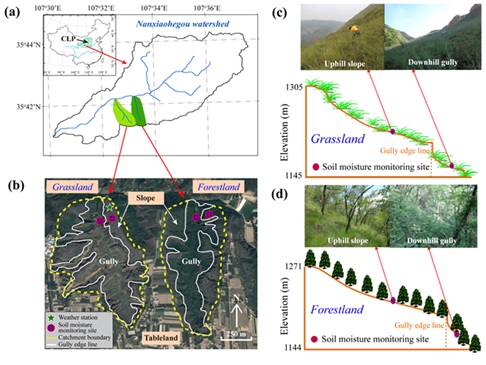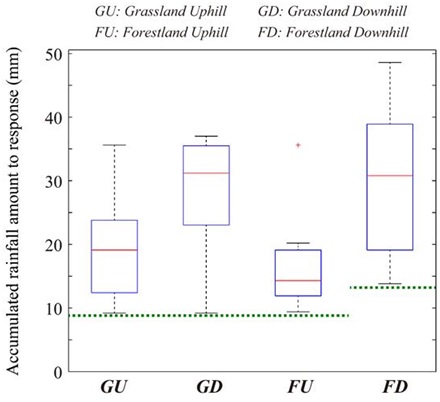
Water balance and soil erosion are two core issues in the ecosystem management of the Loess Plateau of China (CLP). Studies demonstrated that soil erosion rate on the CLP and sediment load in the Yellow River significantly decreased due to the implementation of Grain for Green Project on the CLP during the past 20 years.
Vegetation rehabilitation play a significant role in controlling soil erosion on the CLP. However, the amount of water resources on the CLP also significantly decreased due to the increased cover of vegetation, and many well-revegetated catchments have not generated stream flow for many years.
It's important to understand the mechanisms and thresholds of soil water recharge and runoff generation after the long-term human and natural vegetation rehabilitation on the CLP.
Dr. JIN Zhao from the Institute of Earth Environment (IEE) of the Chinese Academy of Sciences, in collaboration with domestic and overseas scientists, chose a pair of catchments on the CLP (forested and natural regrowth) to explore the mechanisms and thresholds of soil water recharge under the human and natural well-revegetated ecosystems (Fig. 1).
The researchers found that at least an accumulated rainfall amount of 9 mm was required to effectively recharge the surface soil moisture (10 cm) in the natural regrowth of grassland sites (uphill slope and downhill gully), whereas at least 14 mm of rainfall was required for the forestland gully site covered by dense undergrowth and trees (Fig.2).
The results indicated that vegetation rehabilitation contributed a lot in regulating rainwater infiltration and runoff generation. The research also revealed the transient dynamics of soil moisture after rainfall on the CLP and that vegetation, topography, and rainfall attributed together to determine rainwater infiltration and soil moisture replenishment.
Afforestation and natural regrowth of grasslands are the two mostimportant measures for vegetation restoration on the CLP, there is a trade-off between the impacts of afforestation and natural recovery of grassland on soil and water conservation.
Natural regrowth of grassland is beneficial to water resources balance, thus many studies recommend that natural regrowth can offer a more adaptive method of ecological restoration onthe CLP. In this study, researchers found that soil moisture was depleted the most at the forestland gully site after the 60-year vegetation rehabilitation.
However, many studies indicated that afforestation is more efficient in flood control and soil erosion reduction than natural regrowth of grassland on the CLP. Therefore, a more comprehensive evaluation of the ecosystem services, especially the critical zone services of the two vegetation measures on the CLP should be considered in the future.
The study entitled "Soil moisture response to rainfall on the Chinese Loess Plateau after a long-term vegetation rehabilitation" was published in Hydrological Processes.

Fig.1 The study site is located in the Chinese Loess Plateau (CLP) in northern China. The paired catchments are selected in the Nanxiaohegou watershed after a long-term vegetation rehabilitation, including a grassland catchment (c) and a forestland catchment (d). (Image by IEE)

Fig.2 The accumulated rainfall amount before the soil moisture at 10 cm depth responding to all of eight responded rainfall-soil moisture response processes across the four monitoring sites. The green dashed lines indicate the threshold rainfall amount to trigger soil moisture response at 10 cm depth. (Image by IEE)

86-10-68597521 (day)
86-10-68597289 (night)

86-10-68511095 (day)
86-10-68512458 (night)

cas_en@cas.cn

52 Sanlihe Rd., Xicheng District,
Beijing, China (100864)

